-
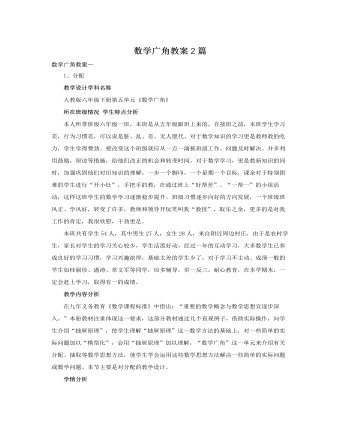
人教版新课标小学数学六年级下册数学广角教案2篇
一、创设情境,猜想验证1.猜一猜,摸一摸。一盒粉笔若干支,5种不同的颜色。至少摸几支能保证:(1)2支同色的。(2)3支同色的。(3)4支同色的。2.想一想,摸一摸。请学生独立思考后,先在小组内交流自己的想法,再动手操作试一试,验证各自的猜想。在这个过程中,教师要加强巡视,要注意引导学生思考本题与前面所讲的抽屉原理有没有联系,如果有联系,有什么样的联系,应该把什么看成抽屉,要分放的东西是什么。二、观察比较,分析推理1.说一说,在比较中初步感知。2.想一想,在反思中学习推理。三、深入探究,沟通联系四、对比练习,感悟新知1.说一说。把红、黄、蓝、白四种颜色的球各10个放到一个袋子里。至少取多少个球,可以保证取到两个颜色相同的球?2.算一算。向东小学六年级共有370名学生,其中六(2)班有49名学生。请问下面两人说的对吗?为什么?五、总结评价六、布置作业
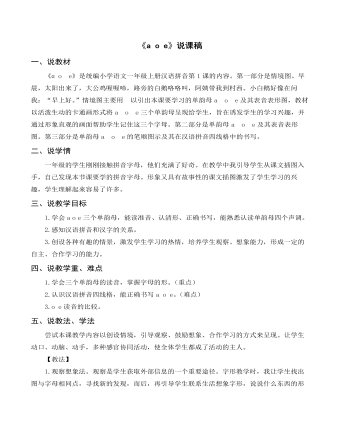
部编人教版一年级上册《a o e》说课稿
一、说教材《ɑ o?e》是统编小学语文一年级上册汉语拼音第1课的内容。第一部分是情境图。早晨,太阳出来了,大公鸡喔喔啼,路旁的白鹅咯咯叫,阿姨带我到村西。小白鹅好像在问我:“早上好。”情境图主要用?以引出本课要学习的单韵母a?o?e及其表音表形图,教材以活泼生动的卡通画形式将a?o?e三个单韵母呈现给学生,旨在诱发学生的学习兴趣,并通过形象直观的画面帮助学生记住这三个字母。第二部分是单韵母a?o?e及其表音表形图。第三部分是单韵母a?o?e的笔顺图示及其在汉语拼音四线格中的书写。二、说学情一年级的学生刚刚接触拼音字母,他们充满了好奇。在教学中我引导学生从课文插图入手,自己发现本节课要学的拼音字母。形象又具有故事性的课文插图激发了学生学习的兴趣,学生理解起来容易了许多。三、说教学目标1.学会a o e 三个单韵母,能读准音、认清形、正确书写,能熟悉认读单韵母四个声调。2.感知汉语拼音和汉字的关系。3.创设各种有趣的情景,激发学生学习的热情,培养学生观察、想象能力,形成一定的自主、合作学习的能力。
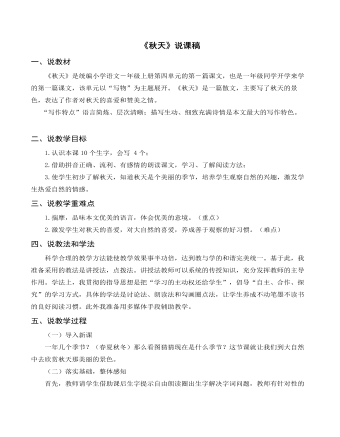
部编人教版一年级上册《秋天》说课稿
一、说教材《秋天》是统编小学语文-年级上册第四单元的第-篇课文,也是一年级同学开学来学的第一篇课文,该单元以“写物”为主题展开。《秋天》是一篇散文,主要写了秋天的景色,表达了作者对秋天的喜爱和赞美之情。 “写作特点”语言简炼、层次清晰;描写生动、细致充满诗情是本文最大的写作特色。 二、说教学目标1.认识本课10个生字,会写 4个;2.借助拼音正确、流利、有感情的朗读课文,学习、了解阅读方法;3.使学生初步了解秋天,知道秋天是个美丽的季节,培养学生观察自然的兴趣,激发学生热爱自然的情感。
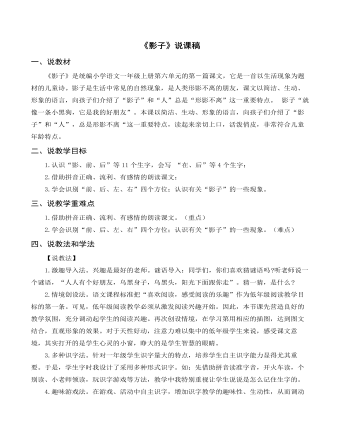
部编人教版一年级上册《影子》说课稿
【说学法】1.合作学习法。以学生为本、小组合作、生生互助的形式来学习,培养学生在合作中取长补短,互帮互助的合作精神。 同组一起把生字读两遍。然后互相检查看看是否读准字音。并说说自已是怎样记住哪个字的,让学生感受合作学习的快乐。 2.朗读比赛法。为了达到正确、流利地朗读课文的目的。让学生利用多种形式读。如:同桌对读,个别读,小组读等方法,贯穿始终,读中悟,悟中读,收到以读代讲以读悟情的效果。 3.自主评价法。通过让学生自主评价,培养学生倾听,欣赏以及表达能力。从而使低年级学生从小养成学习语文的良好习惯。 五、说教学过程(一)谜语导入,揭示课题1.出示谜语,引出“影子”。? 你有我有他也有,黑身黑腿黑黑头。灯前月下跟你走,就是从来不开口。? (设计意图:猜谜语是小学生喜欢的活动。这个谜语不仅引出了课题,而且呈现了本课要学习的生字,可以给学生一个初步的认识。)
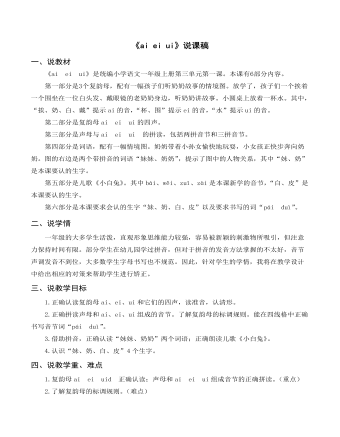
部编人教版一年级上册《ai ei ui》说课稿
一、说教材《ai?ei?ui》是统编小学语文一年级上册第三单元第一课。本课有6部分内容。第一部分是3个复韵母,配有一幅孩子们听奶奶故事的情境图。放学了,孩子们一个挨着一个围坐在一位白头发、戴眼镜的老奶奶身边,听奶奶讲故事。小圆桌上放着一杯水。其中,“挨、奶、白、戴”提示ai的音,“杯、围”提示ei的音,“水”提示ui的音。第二部分是复韵母ai?ei?ui的四声。第三部分是声母与ai?ei?ui?的拼读,包括两拼音节和三拼音节。第四部分是词语,配有一幅情境图。奶奶带着小孙女愉快地玩耍,小女孩正快步奔向奶奶。图的右边是两个带拼音的词语“妹妹、奶奶”,提示了图中的人物关系,其中“妹、奶”是本课要认的生字。第五部分是儿歌《小白兔》。其中bái、wěi、zuǐ、zài是本课新学的音节,“白、皮”是本课要认的生字。第六部分是本课要求会认的生字“妹、奶、白、皮”以及要求书写的词“pái?duì”。
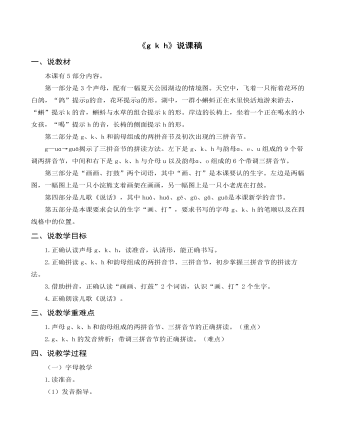
部编人教版一年级上册《g k h》说课稿
2.识记形。(1)观察字形。除了引导学生从情境图中花环、水草和蝌蚪的组合、椅子的侧面等帮助记忆ɡ、k、h的形体外,还要引导学生充分发挥想象来记忆,教师在课前也可以收集一些图片帮助学生记忆。(2)书写字母。声母ɡ、k、h书写指导时,要注意两个新的笔画名称,“”叫竖左弯,“”叫左斜右斜。教师可边示范边讲清字母书写的笔顺和在四线三格中的位置。ɡ两笔写成,占中格和下格。书写时要注意“”的竖要写得直。k两笔写成,占上格和中格。书写时注意“”是一笔完成。h两笔写成,占上格和中格。书写时要注意第一笔竖要占到上格,和n的字形区分开来。(二)拼读教学1.两拼音节。教师要引导学生运用前面所学的方法自己拼读两拼音节,先个体拼读,然后和同伴互相评议。对学生不易区分的ɡù、kǔ、hǔ,教师要加以重点指导。拼读练习时,要和学生熟悉的汉字、事物联系起来,也可以进行适度的拓展,增强趣味性。如:2.三拼音节。这是学生第一次接触三拼音节,拼读难度较大。教师要借助拼读示意图讲清拼读规则,然后联系学生熟悉的事物以及识字单元中已学的“火”字,帮助学生正确拼读,降低难度。
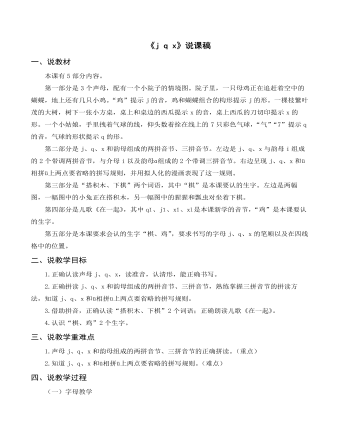
部编人教版一年级上册《j q x》说课稿
本课有5部分内容。第一部分是3个声母,配有一个小院子的情境图。院子里,一只母鸡正在追赶着空中的蝴蝶,地上还有几只小鸡。“鸡”提示j的音,鸡和蝴蝶组合的构形提示j的形。一棵枝繁叶茂的大树,树下一张小方桌,桌上和桌边的西瓜提示x的音,桌上西瓜的刀切印提示x的形。一个小姑娘,手里拽着气球的线,仰头数着拴在线上的7只彩色气球,“气”“7”提示q的音,气球的形状提示q的形。第二部分是j、q、x和韵母组成的两拼音节、三拼音节。左边是j、q、x与韵母i组成的2个带调两拼音节,与介母i以及韵母ɑ组成的2个带调三拼音节。右边呈现j、q、x和ü相拼ü上两点要省略的拼写规则,并用拟人化的漫画表现了这一规则。第三部分是“搭积木、下棋”两个词语,其中“棋”是本课要认的生字。左边是两幅图,一幅图中的小兔正在搭积木,另一幅图中的猩猩和瓢虫对坐着下棋。第四部分是儿歌《在一起》,其中qǐ、jī、xǐ、xì是本课新学的音节,“鸡”是本课要认的生字。第五部分是本课要求会认的生字“棋、鸡”,要求书写的字母j、q、x的笔顺以及在四线格中的位置。二、说教学目标1.正确认读声母j、q、x,读准音,认清形,能正确书写。2.正确拼读j、q、x和韵母组成的两拼音节、三拼音节,熟练掌握三拼音节的拼读方法,知道j、q、x和ü相拼ü上两点要省略的拼写规则。3.借助拼音,正确认读“搭积木、下棋”2个词语;正确朗读儿歌《在一起》。4.认识“棋、鸡”2个生字。

部编人教版一年级上册《江南》说课稿
三、说教学目标1.指导学生认识“江、南、可、等”9个生字。会写“可、东、西”3个字。学习新笔画“竖弯钩”“竖弯”。? 2.引导学生正确流利地朗读课文。背诵课文。感悟江南水乡的美景。? 3.培养学生热爱大自然的感情。四、说教学重难点1.让学生通过识字,能正确流利地读、背古诗。(重点)?2.感悟江南水乡的美景,培养学生热爱大自然的情感。(难点)五、说教法和学法教学是教师和学生互动的一个双边活动,在这个活动中教师是学习的组织者、引导者、合作者,而学生才是学习的主体,因此本节课我采用了“激、促、查、教”等教学方法,指导学生在“自主、合作”中学习,以达到“生成知识、运用知识”的目的。

部编人教版一年级上册《项链》说课稿
四、说教学重难点1.正确、流利地朗读课文,能合理搭配“的”字词语。(重点)?2.感受大海的美丽,知道大海的项链是什么,体会小娃娃海边玩耍的快乐。(难点)五、说教法和学法俗话说:”教无定法,贵在得法”。教学是师生之间、学生之间交往互动、共同发展的过程。建构主义理论强调以学生为中心,强调学生对知识的主动探索、主动发现和对所学知识的主动建构。在教学这一过程中,学生是学习的中心,教师在整个教学过程中起组织者、指导者、帮助者和促进者的作用。? 因此,遵循学生的认知规律,突出教师为主导,学生为主体的教学原则,本节课主要采用学案导学、闯关游戏、小组竞赛的方式进行学习。教师主要为学生创设问题情境,引导学生在对话、讨论、交流中觅取新知,启发、点拨学生通过分析人物的心理描把握人物形象、领悟小说主旨。为了提高课堂学习效果,主要利用多媒体课件和学案来进行教学。
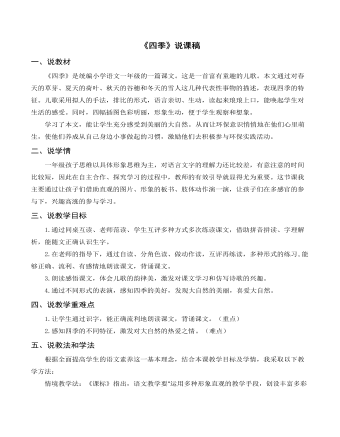
部编人教版一年级上册《四季》说课稿
五、说教法和学法根据全面提高学生的语文素养这一基本理念,结合本课教学目标及学情,我采取以下教学方法:情境教学法:《课标》指出,语文教学要“运用多种形象直观的教学手段,创设丰富多彩的教学情境”。本节课,我通过创设一定情境,激发学生学习兴趣,集中其注意力,拉近学生与文本的距离。以读代讲:本着“以读为本”的教学原则,让学生通过读对课文加深理解,并在图片美的直观感受下读出感情,学生就能进一步的感受感受到语句的优美。叶圣陶先生指出,“教师之为教,不在于全盘授予,而在相机诱导”。学习中突出学生的主体地位,让学生放开手脚,积极参与。本课我指导学生用如下方法进行学习:朗读感悟法:《课标》指出小学各年级的阅读教学都要重视朗读。要让学生充分的读,在读中整体感知,在读中有所感悟,在读中培养语感,在读中受到情感的熏陶。本节课,我让学生通过多种形式的读来感受文中蕴涵的情感。自主合作学习方法:合作学习,培养学生合作意识和自主学习能力。
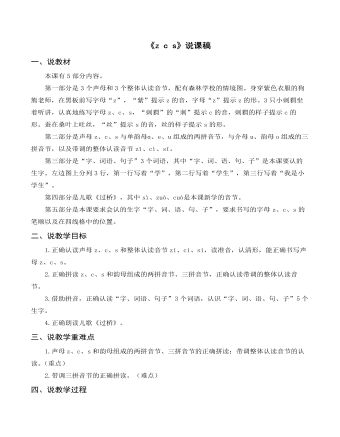
部编人教版一年级上册《z c s》说课稿
一、说教材本课有5部分内容。第一部分是3个声母和3个整体认读音节,配有森林学校的情境图。身穿紫色衣服的狗熊老师,在黑板前写字母“z”,“紫”提示z的音,字母“z”提示z的形。3只小刺猬坐着听讲,认真地练写字母z、c、s,“刺猬”的“刺”提示c的音,刺猬的样子提示c的形。蚕在桑叶上吐丝,“丝”提示s的音,丝的样子提示s的形。第二部分是声母z、c、s与单韵母ɑ、e、u组成的两拼音节,与介母u、韵母o组成的三拼音节,以及带调的整体认读音节zǐ、cì、sī。第三部分是“字、词语、句子”3个词语,其中“字、词、语、句、子”是本课要认的生字。左边图上分列3行,第一行写着“学”,第二行写着“学生”,第三行写着“我是小学生”。第四部分是儿歌《过桥》,其中sì、zuò、cuò是本课新学的音节。第五部分是本课要求会认的生字“字、词、语、句、子”,要求书写的字母z、c、s的笔顺以及在四线格中的位置。

人教版高中英语必修4Body Language说课稿4篇
Textbook: Senior English for China (Book 4), by Liu Daoyi Time Allotment: 1 period (40 minutes)Date: March 20, 2014Teaching aids: blackboard, Multi-media, Power Point, chalk I. Text Analysis (教材分析)This unit is about body language, and the text selected in the reading part demonstrates the difference and similarity of body language in many parts of the world. Through learning this passage, students are required to raise their awareness of using body language in different parts of the world. As body language is closely related to our daily life, it is easy to arouse students’ interest in learning this text. Reading skills and speaking training are designed around the text.II. Teaching Objectives (教学目标)By the end of the lesson, students will be able to:1. Language Skill Objective(语言技能目标): develop reading ability (skimming and scanning)as well as speaking ability.2. Cultural Knowledge Objective(文化知识目标): know about the cultural differences of using body language.3. Affective Objective(情感目标): increase students’ awareness of using body language correctly in different cultures. III.Teaching Focuses and Difficulties(教学重点和难点)1. Teaching Focuses(教学重点): the difference and similarity of body language in many parts of the world.2. Teaching Difficulties(教学难点): develop students’ reading abilities of skimming and scanning and ask the students to show their opinions with fluent English.

人教版高中英语必修4Women of achievement说课稿4篇
Good morning, distinguished judges:It’s my honor to talk about my teaching ideas with you. Today my topic is Women of Achievement. My presentation consists of six parts: the analysis of teaching material and student, teaching aims, key and difficult points, teaching and studying method, teaching procedures and blackboard design.First, let’s focus on the analysis of teaching material. This lesson is from New Senior English for China Student’s Book 4 Unit 1, the reading part. The main topic of the passage is the introduction of a student of Africanwildlife. After this lesson, the students will learn more information about her studying chimps in Africa, and their reading and speaking abilities can be developed as well.The next part is the analysis of students. My students are in senior high students. They have learnt English for many years, they’ve known many words and sentences, but their speaking and reading abilities are still not very good. So I will practice their speaking and reading abilities through different exercises.According to the New Standard Curriculum and the present situation, I set the teaching aims as follows: firstly, knowledge aims. Students can grasp some new words, such as worthwhile, move off. Moreover, students can understand the content of the passage and get familiar with the topic of studying chimps in wildlife. Secondly, ability aims. Students can use reading strategies such as skimming and scanning in reading process. Thirdly, emotional aims. Students can have the awareness of protecting animals and care about animals.Based on the above analysis, the key point of this lesson is to get the main idea and the detailed information from the passage; the difficult point is to talk about the wildlife protection and use reading strategies.

人教版高中英语必修3Canada-the true north说课稿4篇
Good afternoon, teachers, It’s my great pleasure to be here sharing my lesson with you.The content of my lesson is Senior English Book 3 Unit 5 Canada —— “The true North”.I’ll be ready to begin this lesson from five parts. Analysis of the teaching material,the teaching methods,the studying methods, the teaching procedure,and Blackboard design.First, let me talk about the teaching material.Part 1 Teaching Material:This unit is about the introduction of Canada. By studying of this unit,we’ll enable the students to learn the geography, population, main cities, and natural beauty, natural resources of Canada. Through the training of the unit, it also requires students to learn some Language skills such as the expressions of position and emotions.So it plays an important part in the English teaching in this book.After studying the teaching material and analyzing the rule of children’s growing of mind,I think the teaching aims are the followings:1.Knowledge objects:(1) make the students learn some new words and phrases(2) make the students understand the content of the lesson.2.Ability objects:(1)To develop the Ss’ abilities of listening, speaking, reading and writing. Especially reading and speaking ability.(2) learn to talk about the characters of Canada in English(3)To train the Ss’ ability of working in pairs.3.Emotion objects:(1)Enable students to understand the characters of Canada..(2)Stimulate Ss to work hard to make China stronger.Part 2 Teaching Methods:I think helping students learn to master new words and phrases and improve the students’ reading and speaking ability is import and the difficult.According to the analysis of the teaching material and the import points and the difficult points,I will use the following teaching methods : question-guiding approach; fast-reading and careful reading; multi-media teaching methods; discussion

人教版高中英语必修3Healthy Eating说课稿4篇
Language learning needs a context, which can help the learners to understand the language and then can product comprehensible output, so computer has the advantages to make the materials attractive.Part 3 Learning MethodsTask-based, self-dependent and cooperative learningPart 4 Teaching ProcedureStep One Lead-in“Interest is the best teacher.” Therefore, at the very beginning of the class, I should spark the students’ mind to focus on the centre topic “the band”. I’ll show some pictures of food to attract their attention and then bring some questions.Question:What kind of food they like?What should go into a good meal?The answers must relate to the diet. After this, the students will be eager to know something about a balance diet and this is the very time to naturally lead the class into Step 2Step 2 Reading for information: skimming and scanning In this step, I use Task-based Language Teaching method, which can give students a clear and specific purpose while skimming and scanning the context.Task 1 General ideaThe students will be asked to just glance at the title and the pictures of the passage, and then guess what they will read in the text. And they’ll be divided into groups of four to have a discussion.The purpose is to inspire the students to read actively, not passively. In addition, the task is to develop the students’ reading skill by making prediction and to encourage the students to express their thoughts in English and cooperate with each other.Task 2 Main idea of each paragraphCooperative learning can raise the students’ interest and create an atmosphere of achievement. Based on this theory, I divide the whole class into 4 groups to skim the whole text and get the main idea of each paragraph.

人教版高中英语必修5Great scientists说课稿4篇
通过写文章梗概,培养学生综合运用语言的能力,学习用恰当的英语描述科学家的故事。这是本课的教学难点。教师可以使用完形填空的方式来帮助学生整理语篇,从而来降低难度。本课的教学重点的突破方法是:在阅读前,让学生初步了解得出科学观点所需要的基本程序,从而轻松而自然地导入文章的阅读;在阅读过程中,由易到难设计快速阅读和精读的问题,层层推进各种阅读活动,让学生对阅读内容从整体感知到细节理解,最后深层读懂整篇文章,同时加强阅读策略的指导,让每个学生都主动参与课堂教学活动,最终达到提高阅读能力的目的。Step 4 Post-readingGroup Activities四人小组共同合作,在老师的适当指导下,就以下2个问题展开讨论,让学生就所知、所学、所感和所想融入话题,然后抽若干同学代表作小组发言。1. What do you think about John Snow, and what should we learn from him?2. Cholera was 19th century disease, which two diseases are similar to cholera today? Why?

人教版高中英语必修5Making the news说课稿4篇
今天我们来介绍一下必修五第四单元的授课方式。这个单元的题目是Making the news。应该是学生比较感兴趣的话题,学生往往对新闻工作充满好奇,所以我们可以利用这个机会多设计一些师生互动和学生互动,来激发起学习的积极性,提高学习效率。同时我们可以利用这个单元不仅帮助学生掌握语言知识,培养语言能力,同时让其了解新闻工作的重要性,培养起社会智能感。这个单元分为六个课时,它的教学目标是这样的:语言目标是掌握词汇表中的常用单词和短语,掌握倒装句的一些基本用法。 技能目标是能初步掌握约会的基本句型并在真实的场景下正确运用。新闻报道类文章的写作技能。采访的基本规范和沟通技能。情感目标是对新闻报道的客观性和真实性有更好的理解。对新闻记者的职业有更深入的了解,并能体会其工作的重要性。下面我们来介绍一下第一课时的授课方式,第一课的教学目标是这样的第一课时的教学目标语言目标:单词:Occupation, journalist, editor, photographer, curious, personality, enthusiasm

人教版高中英语必修5The United Kingdom说课稿4篇
Teaching Aims:Knowledge 1. Get the students to learn the useful new words and expressions in this section. Aims:2. Let the students learn about how the UK was formed and the four groups of invaders.1. Develop students’ reading ability and let them learn different Ability reading skills. Aims:2. Enable students to learn to talk about the United Kingdom and the Union Jack Emotional 1. Let students know more about the UK2. Develop students’ sense of cooperative learning Aims:Teaching Important Points:1. Let the students learn about the countries of the United Kingdom and the Union Jack2. Get the students to read the passage and know about how the UK was formed and the four groups of invaders.3. Have the students learn different reading skills.Teaching Difficult Ponts:1. Develop students’ reading ability.2. Enable students to talk about the United Kingdom and the Union Jack.3. Let students learn how the UK was formed geographically and historically.Teaching Methods:Showing pictures, asking, exercising, listening, reading etc.Teaching Aids:A computer,a projector and a blackboard.Teaching Procedures: 1) Show a map of the world, ask students the following questions:Where is the UK?What’s the full name of the UK?2) Ask the students work in pairs to do the quiz on Page 9.Do you want to test how many things you know about the United Kingdom? Let’s have a small test.Using the map on P9, students answer the following questions:?How many countries does the UK consist of? What are they??England is divided into three main areas. Do you know what they are? 1) Scanning (10Minutes )Let the students hold the questions asked in pre-reading and read the passagequickly and then let them do the following exercise.Join lines to the right answer.
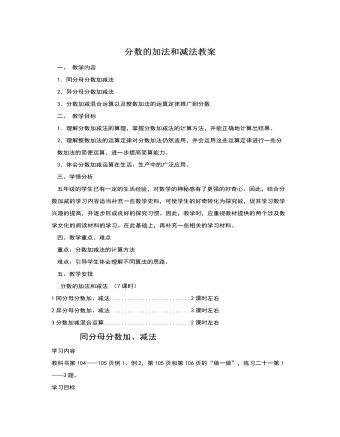
人教版新课标小学数学五年级下册分数的加法和减法教案
二、 教学目标1.理解分数加减法的算理,掌握分数加减法的计算方法,并能正确地计算出结果。2.理解整数加法的运算定律对分数加法仍然适用,并会运用这些运算定律进行一些分数加法的简便运算,进一步提高简算能力。 3.体会分数加减运算在生活、生产中的广泛应用。三、学情分析五年级的学生已有一定的生活经验,对数学的神秘感有了更强的好奇心。因此,结合分数加减的学习内容适当补充一些数学史料,可使学生的好奇转化为探究欲,促其学习数学兴趣的提高,并逐步形成良好的探究习惯。因此,教学时,应重视教材提供的两个涉及数学文化的阅读材料的学习。在此基础上,再补充一些相关的学习材料。四、教学重点、难点重点:分数加减法的计算方法难点:引导学生体会理解不同算法的思路。
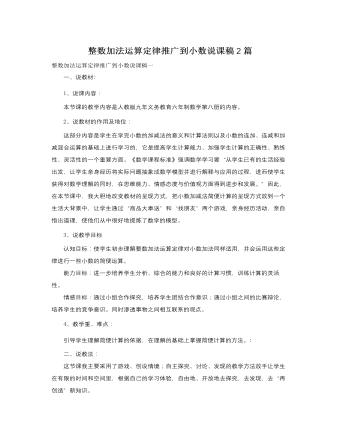
人教版新课标小学数学四年级下册整数加法运算定律推广到小数说课稿2篇
1.揭示课题那么,这个运算定律是否对分数加法也适用呢?现在我们就来研究这个问题。板书课题:整数加法运算定律推广到分数加法。2.研究运算定律对分数加法的适用性出示式题:提问:上面每组算式的左右两边有什么关系?得数是否相等?先指名学生练习,算出得数后,再引导学生观察。提问:这两组试题有何共同之处?组织学生开展小组讨论,共同概括总结出他们的共同点,得出规律性的认识,从而使学生体会到整数加法运算定律,对分数加法同样适用。通过讨论明确:加法的交换律、结合律中的数,既包括了整数,又包括了小数和分数。【设计意图】通过具体的实践活动,直观感知了加法运算定律同样也适用于分数加法。这种通过自己实践得来的东西,学生理解得更透,掌握得更牢。